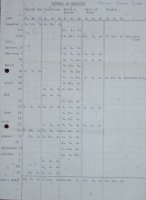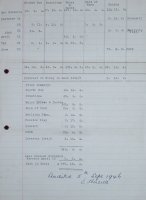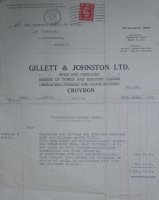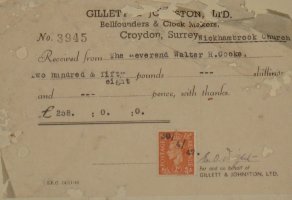  |
 |
 |
 |
 |
| Sun 06 Jul 2025 |

The History Of All Saints' WickhambrookMemorial Clock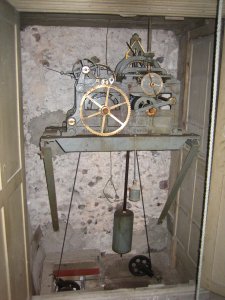
Original mechanism of the clock - hand wound Made by Gillett and Johnston, The Croydon Bell Foundry Ltd and dated 1947, the clock was installed as a memorial to the fallen in both world wars. The dial which is situated on the north wall of the tower, facing the road, measures 11ft 6ins (3.5m) in diameter. The clock mechanism is housed in a wooden cabinet in the clockroom just below the belfry in the tower. The clock room is 11ft x 11ft 5ins (3.4m x 3.5m) in size. The clock hammer strikes the tenor bell. On the hour hand setting dial the inscription reads "Gillett and Johnston Croydon, by Royal warrant clockmakers and bellfounders to King George V". On the frame of the mechanism is stated that Gillett and Johnston are "Makers of Tower Clocks, Carillons, Bells for Ringing or Chiming" The mechanism is designed to run without oil. Indeed lubrication can be achieved by the use of graphite powder which is almost frictionless and acts as a solid lubricant. The choice of an oil-free lubricant is to stop dirt particles sticking to the lubricant causing wearing of the mechanism. However the mechanism is kept oiled using a recommended oil. 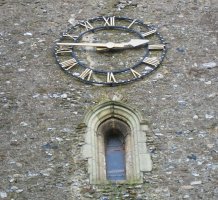
The clock dial on the north face of the tower During the Phase 1 restoration work the clock face dial numbers and hands were re-painted in gold-leaf paint. This highlights superbly its features as it is offset admirably by the darker hue of the tower itself. The re-gilding of the clock face was paid for by kind donations from two benefactors. Gillett and Johnston's other famous clocks include that of St Paul's Cathedral in London. clock winding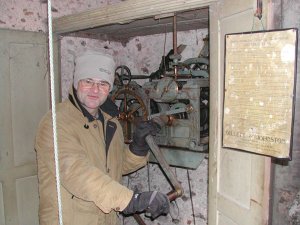
Mike Chester - churchwarden - pictured winding the clock From the day it was installed until the electrification of the winding mechanism in March - April 2007, winding the clock (which had to be done twice a week) was always a very strenuous job. Firstly there are the 37 steps of the tower to negotiate then the mechanism itself to deal with. There are two sets of weights. The first and heavier weights are for the clock mechanism itself and requires about 30 turns if the weights are fully down. The second set is for the chiming mechanism and this requires about 35 turns of the mechanism to fully wind it. Not a job for the faint-hearted. For many years the job of winding the mechanisms was performed by William (Jack) Stutters. A job he did along with ringing the bell on Sunday for well over 40 years. (Further information about Jack Stutters can be found in the book "Ten Miles From Anywhere" pp147 by John Bean - Hedgerow publishing ISBN 0-9525440-0-8.) When he relinquished this job in 1997, the mantle was passed to Mike Chester who was the main clock winder until electrification. Mike was also chief mechanic and with loving care kept the clock in excellent working order; fixing it whenever it stopped. Mike moved in 2010 and repairs now rest with the Haward Horological based in Ipswich who are DAC approved. As mentioned above due to the physical effort required and the frequency of winding needed to keep the clock working and chiming a Faculty was applied for and duly received on 23rd February 2007 for the electrification of the winding mechanism. For the process of electrification the entire clock mechanism was taken away to Croydon to be cleaned and overhauled by Gillett and Johnston. They have since returned the mechanism and installed the electric winding mechanism. So after 60 years the clock no longer needs winding by hand. The electrification was paid for in part by money raised for the restoration of All Saints' church and in part by a donation by Wickhambrook Parish Council. 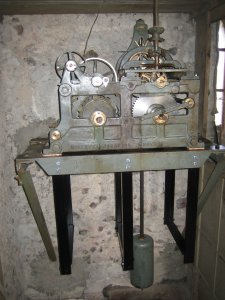
Restored clock mechanism ready for electrical winding mechanism 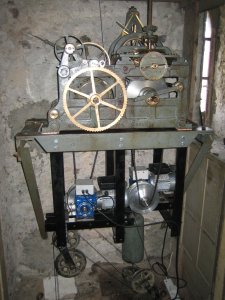
Restored clock mechanism with electrical winding mechanism Leading-Off WorkThe leading-off work is the series of cogs and rods that transmit the movement generated by the pendulum's action into mechanical movement of the clock hands. Often this can go wrong over the years and this is no exception for All Saints' clock which resulted in the clock stopping a number of times a week in late 2010 and early 2011. The clock as assessed by the Diocesan Advisory Committee (DAC) clock expert Ian Coote who advised that the probable cause for the clock repeatedly stopping was due to a fault / wear and tear in the leading-off work. "The clock (Gillett and Johnston ca. 1947) was overhauled by the manufacturers a few years ago, so is in good condition generally, but it stops periodically. The current problem is clearly in the leading-off work, or within the dial mechanism. It was not possible to investigate further, but it is most likely to be in the pipe carrying the drive to the hands." Ian Haward from Haward Horological was appointed to make good the defective leading-off work. This he duly did on the 2nd June 2011 at a cost of £576. Since the clock is a village memorial to the War Dead a case was made to County Councillor Jane Midwood who kindly paid for the work from her Locality Fund. About the clockOnce it was decided by the village that a clock was to be installed in the church as a memorial to those who gave their lives in the two World Wars a series of fund raising activities were undertaken. Over the period December 1944 - June 1946 the required money was raised. The mechanism and clock face were installed between January and March 1947 at a cost of £258:0:0. Memorial Clock benefactors
Gillett & Johnston FoundryGillett and Johnston were international standard clockmakers and bellfounders who supplied worldwide contractors as well as the Government and various public bodies. From 1844 to 1950 over 14,000 tower clocks were made at the foundry. The famous 72-bell carillon, the largest in the world, was made for John Rockefeller Jr to be based in New York, as was the ten and a half ton 'Freedom Bell' for West Berlin's Town Hall. The foundry at Union Road was established in 1844 and by 1868 was one of the first steam powered clock factories in the world. The clocktower was added to the works as a working advertisement. Each of the clockfaces was different and unique, being hand finished by skilled workmen. Cyril Johnston, once described as 'the greatest bellfounder ever' was granted the OBE a few months before his death in 1950. The clockfaces have been removed and put into storage until a suitable home is found for them. The foundry was demolished in 1997. To find out more about the company of Gillett and Johnston visit their website at http://www.gillettjohnston.co.uk/. To find out further details about some of the famous bells and clock this company cast and installed try this search engine results page. |

